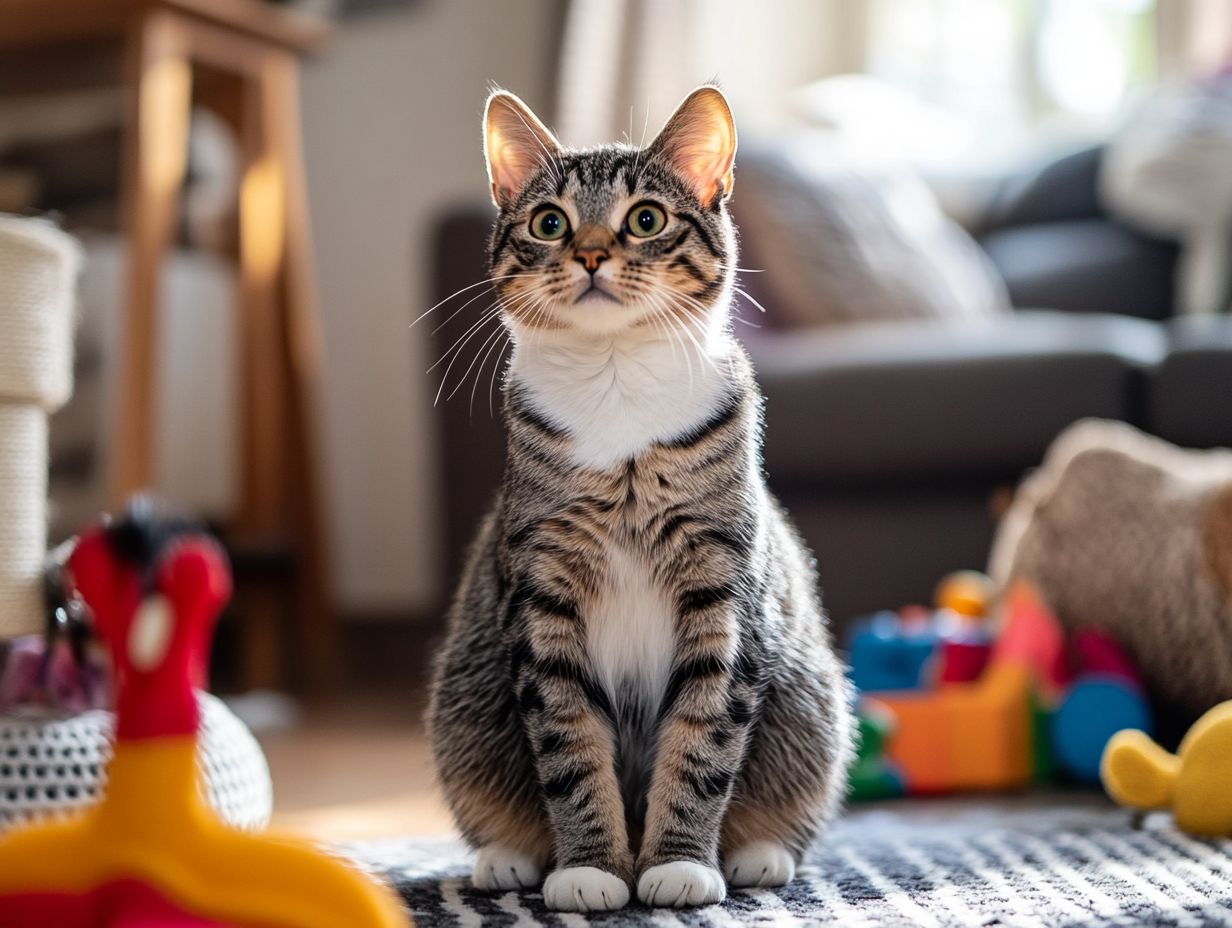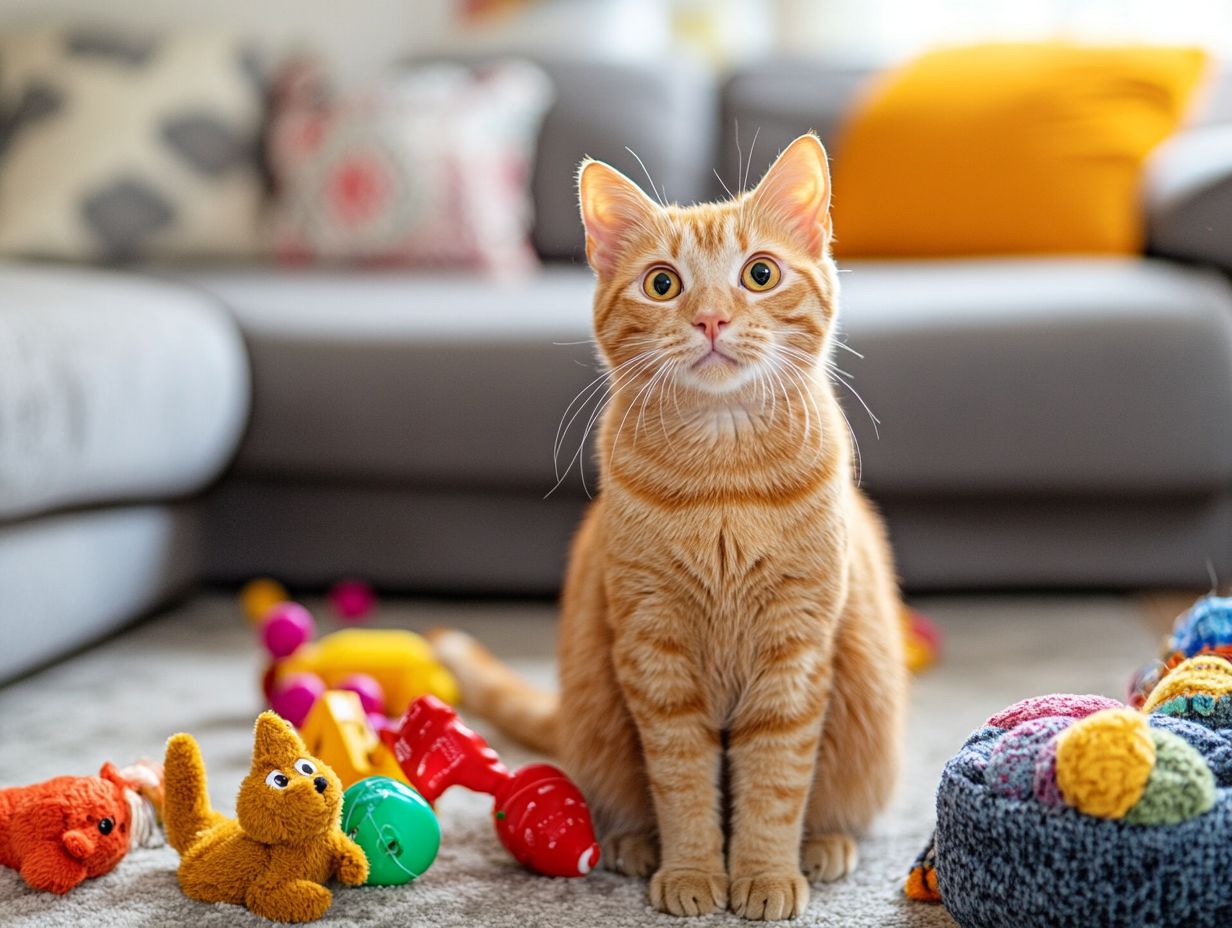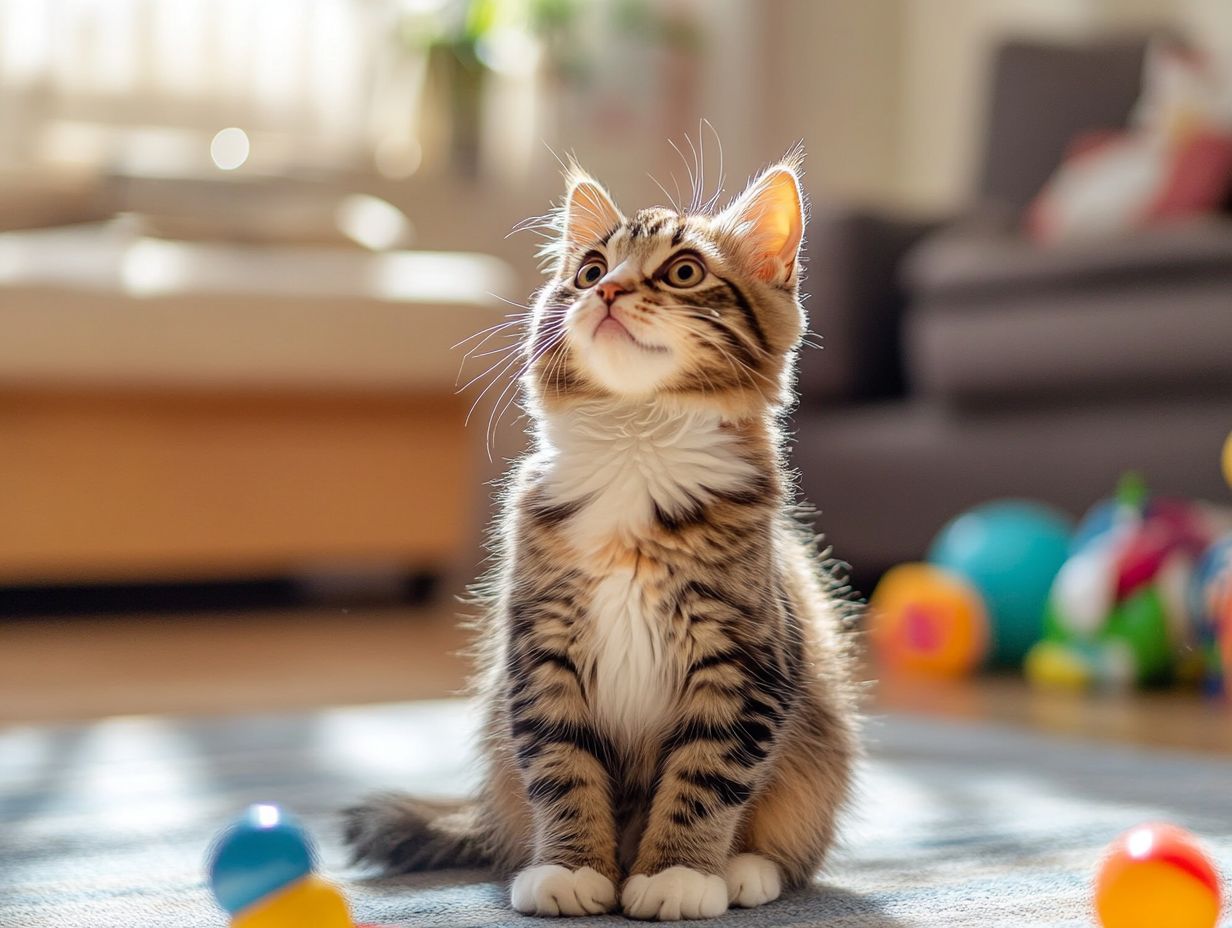Understanding your cat’s body language can significantly enhance your relationship with your feline friend. Cats convey a wide range of emotions and intentions through their postures, tail movements, and facial expressions.
This guide will assist you in interpreting these signals, enabling you to bond more deeply with your cat. Additionally, it will explore the key differences in body language between cats and humans, offering practical tips for creating a safe environment that encourages your cat to express itself.
Dive in to discover the secrets of your cat’s communication!
Why Understanding Body Language is Important

Understanding cat body language is essential for pet owners who wish to enhance their relationship with their feline companions. By recognizing subtle signals such as tail and ear positions, owners can gain valuable insights into their cats’ moods and emotions, leading to improved communication.
Identifying feline behavior patterns enables pet owners to respond appropriately to their cats’ needs, fostering a more enriching environment. This not only strengthens the bond between pet owner and cat but also enhances the overall welfare and happiness of the cat, benefiting both parties in the human-animal relationship.
Being aware of these nuances is crucial; for instance, a raised tail typically signifies confidence or happiness, while flattened ears may indicate fear or agitation.
Additionally, the sounds a cat makes can be telling: a soft purr usually signifies contentment, whereas a sudden, shrill meow may indicate distress or a desire for attention. Recognizing when a cat is feeling stressed or aggressive allows owners to take corrective measures to alleviate their distress, ensuring that the animal feels secure.
Cultivating sensitivity to these signals not only improves the pet-owner relationship but also contributes to the cat’s emotional well-being, allowing it to thrive in its home.
Interpreting Common Cat Behaviors
Interpreting common cat behaviors is essential for fostering a harmonious relationship between you and your feline companion. By observing signals such as body posture, tail movements, and eye contact, you can decipher your cat’s emotional state and respond appropriately.
Cats communicate not only through vocalizations like meowing or hissing but also through their physical presence. Understanding these behavioral signs enables you to recognize your cat’s mood—whether they are feeling playful, affectionate, or even stressed—facilitating better interactions.
Postures and Positions

The posture and position of your cat can provide valuable insights into their emotional state and overall well-being. For example, an upright tail signifies happiness and confidence, while a crouched posture may indicate fear or stress. By interpreting these body language cues, you can discern when your cat is feeling playful or relaxed, as opposed to when they are exhibiting signs of discomfort. Observing their postures allows you to tailor your interactions, enhancing their comfort and happiness.
Different postures can reflect a range of emotions and instincts that are essential to your cat’s behavior. A cat lying flat on their stomach with limbs extended often appears relaxed, indicating a sense of security in their environment. In contrast, a puffy tail accompanied by hissing may suggest aggression, signaling that the cat feels threatened and is prepared to defend itself.
When in a defensive posture, such as crouching low with ears flattened, a cat may be ready to either flee or fight, showcasing their instinctual response to stress. By recognizing these cues, you can create a safe space that caters specifically to your cat’s needs, fostering a strong bond built on trust and awareness.
Tail Movements
Tail movements are important indicators of a cat’s emotions and intentions, serving as a significant form of feline communication that pet owners should pay attention to. For example, a high tail is often associated with confidence and happiness, while a puffed-up tail typically signifies fear or aggression. Understanding these tail positions allows pet owners to recognize their cat’s mood and engage with them appropriately, fostering a safer environment that respects their comfort and emotional state.
Observing the subtleties in tail movements can significantly enhance the bond between you and your cat. A slow, sweeping motion may indicate curiosity or playfulness, whereas a tense, swishing tail often signals irritation or annoyance. These nuances provide valuable insights; by recognizing when your cat is feeling stressed or overstimulated, you can adjust your behavior to better accommodate their emotional needs.
A cat that feels understood is more likely to feel secure in its surroundings, leading to a happier and more affectionate companion.
Facial Expressions

The facial expressions of cats may be subtle, but they are very telling signs of their feelings and state of mind. A relaxed face characterized by half-closed eyes and a soft mouth indicates contentment. In contrast, wide eyes and dilated pupils can signify excitement or fear.
Understanding these facial expressions can help you recognize your cat’s emotions and adjust your behavior accordingly, allowing you to identify discomfort or stress that may not be evident in other ways. Additionally, the positioning of their ears and whiskers contributes to this communication. When their ears are facing forward and their whiskers are slightly relaxed, it may indicate curiosity and friendliness.
Conversely, flattened ears and whiskers pulled back can signal agitation or caution. It is also important to recognize that a cat that hisses or displays a stiff posture is likely feeling anxious or distressed.
By being aware of these signals, you can create a more calming environment for your cat, ensuring that they feel safe and secure in their space.
Communicating with Your Cat Through Body Language
Communicating with your cat through body language is essential for strengthening your bond and enhancing mutual understanding. By recognizing your cat’s body language and responding with your own, you create a meaningful communication channel.
For instance, by mimicking your cat’s relaxed body posture or making slow, deliberate gestures, you can convey feelings of safety and affection. Additionally, by observing your cat’s reactions, you can adapt your communication style to better suit the needs of your unique relationship.
How to Use Body Language to Bond with Your Cat

Using body language to bond with your cat can significantly improve your relationship and foster feelings of safety and trust. Approaching your cat with a relaxed posture, initially avoiding direct eye contact, and extending your hand for them to sniff can promote positive interactions.
It’s essential to recognize when your cat shows affection—whether through purring or rubbing against you—so you can respond with gentle strokes or play, thereby reinforcing positive behaviors and strengthening your connection.
Understanding feline emotions is also crucial; for example, a slow blink from your cat is often a sign of love and trust. You can reciprocate this gesture by blinking slowly at them, which may enhance their comfort level. Additionally, using treats or verbal praise during playtime can effectively reinforce good behavior and further solidify your bond.
Consistency is key, as is establishing a routine for feeding and play, which fosters trust and provides a sense of security. Every interaction you have with your cat contributes to their emotional well-being and deepens your bond with them.
Body Language Differences Between Cats and Humans
Understanding the differences in body language between cats and humans can greatly enhance communication and strengthen your relationship with your cat. While humans primarily rely on verbal communication and maintain direct eye contact to convey their messages, cats communicate through body posture, movement, and even the position of their whiskers.
By recognizing these differences in body language, both humans and animals can improve their ability to communicate effectively with one another.
Understanding the Unique Nature of Cats
Understanding the unique characteristics of cats is essential for pet owners, as it enables them to better support their feline companions and enhance their living environment.
By gaining insight into cats’ innate behaviors and instincts, owners can learn how these animals experience the world around them. For instance, a cat’s instinct to hunt is often mirrored in its play behavior, which is crucial for both physical and mental stimulation.
Cats are creatures of habit, favoring consistency in their daily activities and surroundings. This knowledge allows owners to make informed decisions regarding their cats’ environments, feeding schedules, and preferred methods of interaction.
Ultimately, understanding these unique traits helps create a space where cats feel safe, understood, and truly at home.
Tips for Improving Your Cat’s Body Language
Enhancing your cat’s body language is essential for their comfort and happiness, and there are several effective strategies to achieve this.
- Safe Spaces: Creating designated safe spaces where your cat can retreat and relax helps them cope with anxiety and stress, ultimately improving their overall comfort and well-being.
- Enrichment: Providing an enriching environment filled with toys, climbing structures, and other engaging elements ensures that your cat remains happy and healthy, which positively influences their body language.
- Routine: Establishing consistent routines and fostering positive interactions allows your cat to feel safe and secure, enabling them to express their feelings and personalities more effectively.
Creating a Safe and Comfortable Environment
Creating a safe and comfortable environment for your cat is crucial for their emotional health and overall well-being.
Providing safe spaces, such as cozy beds and hideaways, helps to reduce anxiety triggers, allowing your cat to feel secure and relaxed. Along with these safe spaces, you can enhance their environment with vertical climbing structures, engaging toys, and scratching posts that cater to their natural instincts and playful nature.
Utilizing soft, warm lighting and soothing scents can further foster an atmosphere of comfort. It is also important to monitor potential stressors, such as loud noises and unfamiliar guests, as these can significantly impact your pet’s sense of safety.
By implementing these practical strategies, you can promote stress relief and enrich your cat’s daily life.
Certainly! Here’s an additional 300-word section that can be inserted before the conclusion, expanding on the importance of recognizing your cat’s emotional needs and the role of body language in fostering trust and security:
The Role of Emotional Awareness in Feline Body Language
Being in tune with your cat’s emotional needs is vital for nurturing a healthy and trusting relationship. Cats, like humans, experience a range of emotions from happiness and contentment to fear and anxiety.
Understanding the subtle shifts in their body language can help you respond appropriately to their feelings, creating a more secure and harmonious living environment.
One of the key aspects of recognizing your cat’s emotional state is paying attention to their energy levels and behavior changes.
For instance, a sudden increase in hiding or withdrawal can signal stress or discomfort, possibly due to changes in the environment, such as the arrival of a new pet, loud noises, or even a change in routine. Conversely, a sudden burst of activity or overly playful behavior could be an indication of boredom or excess energy.
Furthermore, cats are often more sensitive to their environment than we realize. Factors such as lighting, temperature, and even the layout of your home can affect their emotional well-being.
Ensuring that your home is a safe and stable space where your cat can retreat to when needed is crucial for maintaining their mental health.
Emotional awareness also involves recognizing when your cat is experiencing overstimulation, which can lead to aggression or anxiety.
Cats have a unique way of signaling when they’ve had enough, whether it’s through sudden tail flicks, swatting, or even vocalizations. Responding to these cues with understanding can prevent negative interactions and foster an environment of mutual respect.
By continually observing and interpreting your cat’s body language, you not only enhance communication but also build a deeper, more trusting relationship that allows both of you to thrive.
